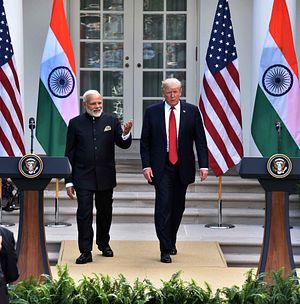Ankit Panda offers a concise summary of what the COMCASA agreement, which ensures cooperation on communications technology and policy, means for the future of U.S.-India relations. It clears up one of the last big roadblocks for U.S.-Indian interoperability, making arms transfers easier and paving the way for improved cooperation on innovation and production. The U.S. Department of Defense has also suggested that India (along with Indonesia and Vietnam) will not be sanctioned under CAATSA for purchasing Russian military equipment.
The closer relationship between the United States and India has big implications for the future of India’s defense industrial base (DIB). India is adopting a technology-management model that resembles that of the United States in some ways, even though the structure of the Indian DIB remains radically different.
As part of this project, India is following through with the plan to stand up a counterpart to the Department of Defense’s Defense Innovation Unit (DIUx). An element of the two-plus-two agreement between the United States and India provided for the creation of a team that would liaise between DIUx and India’s recently created Defense Innovation Organization (DIO). The DIO manages IDEX, the Innovations for Defense Excellence program. DIO and IDEX have the mission of providing a platform for bringing private firms into an arena long dominated by state-owned giants, such as BEL and HAL.
The mission of DIUx is to draw Silicon Valley startups into relationships with the Department of Defense, and thus to capture innovation in the technology sector necessary to making the “Third Offset” work. The DIO and IDEX have a similar mission; taking advantage of India’s robust technology sector to facilitate the integration of dual-use technologies into the DIB. This includes measures such as reassuring small firms about the security of their intellectual property, and the viability of long-term investment in defense projects.
Notwithstanding Indian doubts about the future of the relationship with the United States, the measures that Washington and New Delhi have taken to provide for defense cooperation imply a long-term commitment to an integrated approach to defense integration. And while Russia may remain in the picture for a while (as the CAATSA waiver enables), it’s difficult to imagine a future in which Russia and India engage in much more than arms-length defense transactions for particularly high-quality Russian goods, such as the S-400 air defense system. It is hard to imagine that India can continue to gain much from defense innovation cooperation with the Russian DIB; that ship may have sailed with the failure of the Su-57 stealth fighter.
The fundamental structures for innovation in a defense industrial base in the 21st century are still taking shape. Every model includes public-private cooperation, but the nature of that cooperation varies greatly depending on the relationship between the state, the giants of the defense industry, and the technology sector. Despite its continued reliance on large state owned firms, the Indian government appears to be taking a step in the direction of a U.S. model for innovation.
The views expressed here are the author’s personal views and do not necessarily reflect those of the Department of Defense, the U.S. Army, the Army War College, or any other department or agency of the U.S. government.

































